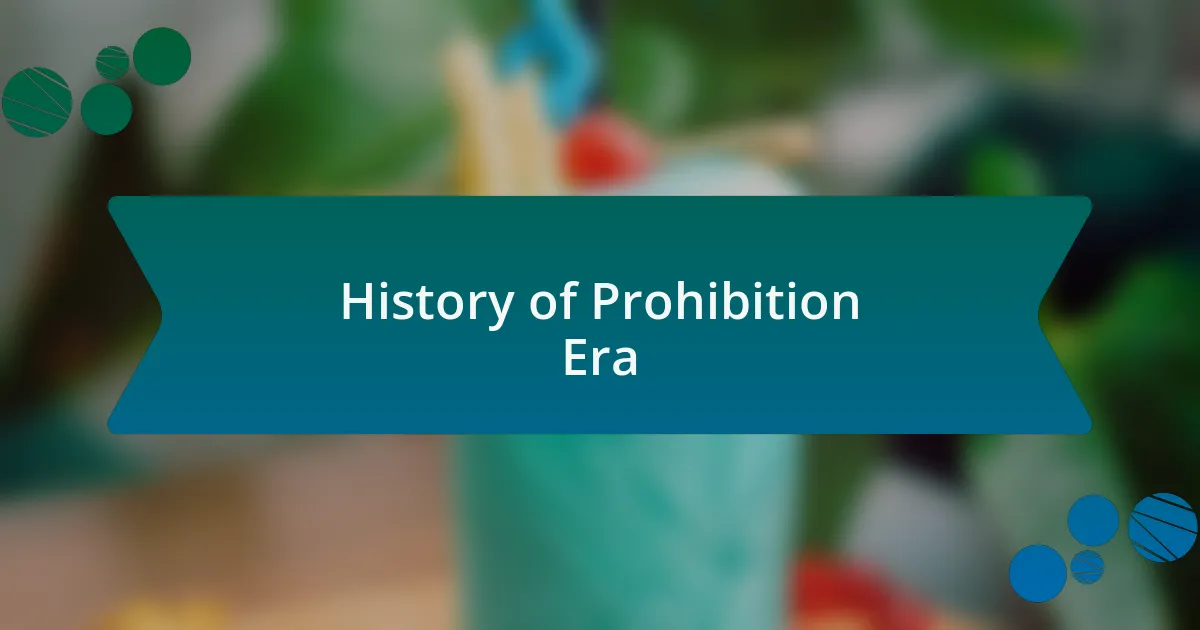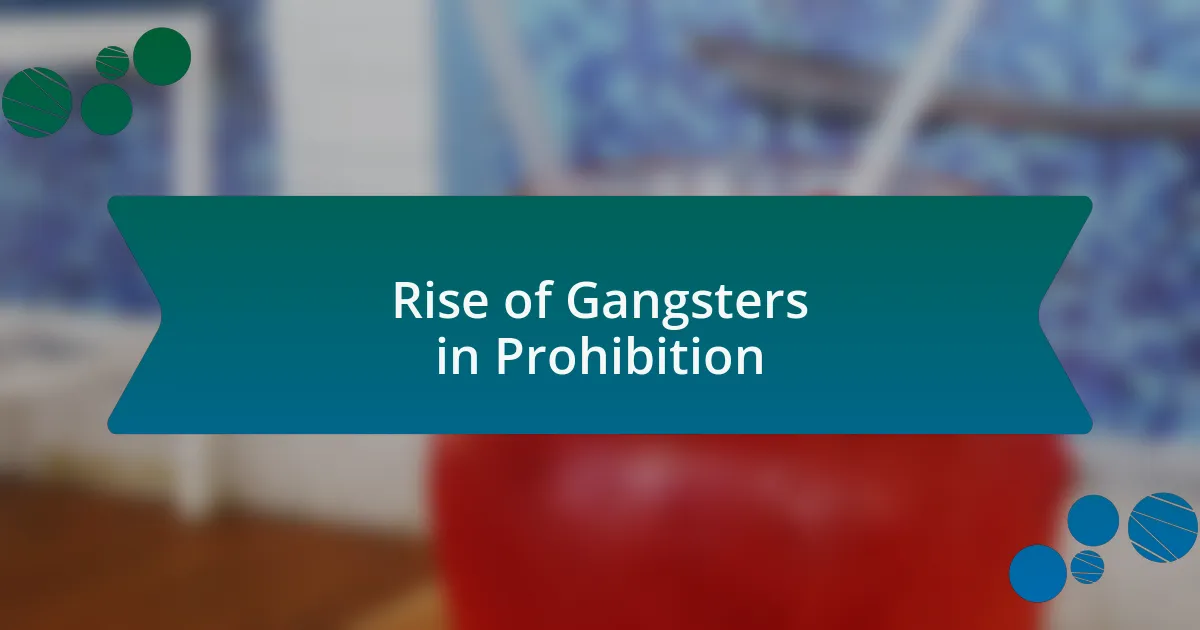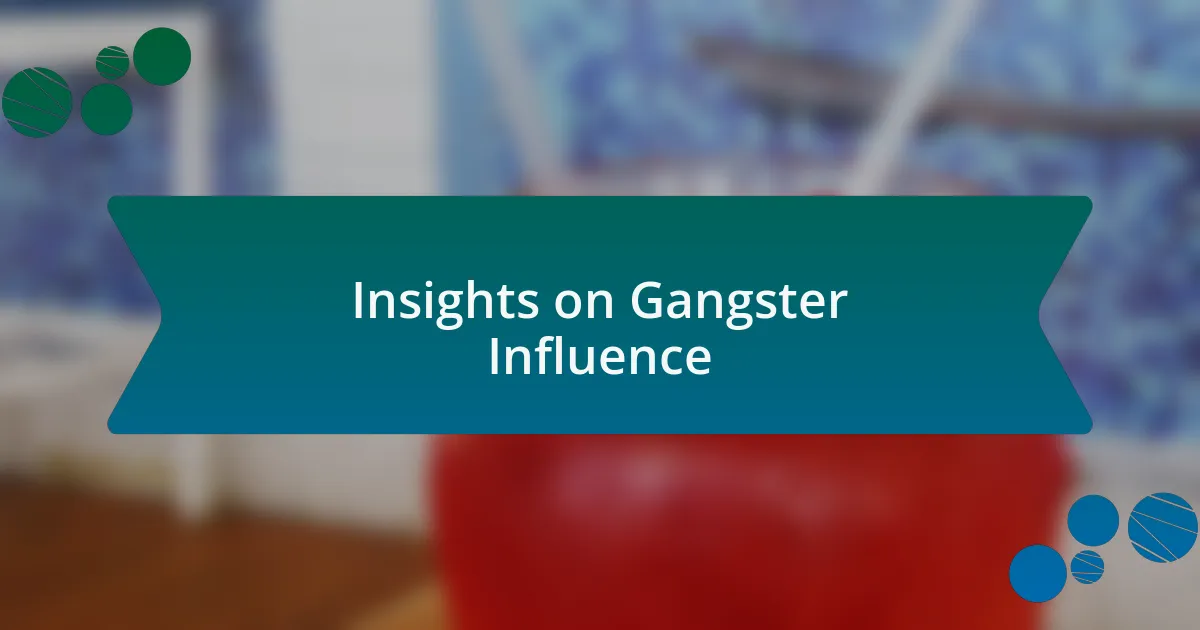Key takeaways:
- Speakeasy bars were secret venues during Prohibition, symbolizing rebellion and community while offering a safe space for socializing and enjoyment of music.
- The Prohibition Era (1920-1933) led to the rise of organized crime, with figures like Al Capone capitalizing on the public’s demand for alcohol and reshaping societal views on legality and morality.
- Gangsters became cultural icons, influencing nightlife and creating a dual identity as both criminals and community leaders, contributing to the allure of speakeasy culture.
- Visiting speakeasy bars today involves embracing vintage styles, engaging with knowledgeable staff for enhanced experiences, and being patient due to the venue’s popularity.

Understanding Speakeasy Bars
Speakeasy bars emerged as secretive hideaways during Prohibition, operating illegally while providing a safe space for patrons to enjoy drinks and music. I often wonder how it felt to step through a hidden door, leaving the chaos of the outside world behind. The thrill of entering a clandestine venue must have added to the allure, transforming an ordinary night out into something extraordinary.
These bars weren’t just about breaking the law; they represented rebellion and resilience during a time when restrictions loomed large. I imagine the lively conversations and shared laughter, creating a sense of community among those who frequented these hidden gems. Can you picture the excitement in the air as jazz music filled the room, each note echoing the spirit of defiance against an oppressive regime?
For me, the essence of speakeasy bars lies in their ability to forge connections and create unforgettable experiences. It’s intriguing to think about how a simple drink could symbolize freedom and camaraderie during such turbulent times. Do you think the stories shared over those clandestine cocktails still resonate today, reminding us of the importance of fellowship and the joys of breaking away from the norm?

History of Prohibition Era
The Prohibition Era, from 1920 to 1933, marked a significant shift in American society. The 18th Amendment prohibited the manufacture, sale, and transportation of alcoholic beverages, resulting in a surge of underground businesses and organized crime. I often find myself reflecting on how this bold attempt to legislate morality inadvertently romanticized drinking culture.
As the law unfolded, gangsters like Al Capone thrived, turning illegal liquor into big business. It’s intriguing to think about the power dynamics at play—how the desire for freedom led to the rise of figures who embraced the chaos. These men capitalized on the public’s thirst for alcohol, and I can’t help but wonder if their influence extended beyond mere profits. Did it change the way people viewed heroes and criminals during that time?
With speakeasies nestled in hidden corners, these secret bars became havens of resistance. I can almost envision the thrill of sipping a forbidden drink, wrapped in an air of secrecy and danger. Did patrons realize they were part of something larger, a movement that challenged societal norms? The vibrant energy in these spaces, filled with jazz and laughter, was a testament to a collective defiance that shaped a distinct chapter in American history.

Rise of Gangsters in Prohibition
The rise of gangsters during Prohibition wasn’t just a side effect of a new law; it was a societal response to an unexpected vacuum. I vividly remember a documentary I watched, showcasing how these gangsters filled the gap left by the government, providing not just alcohol, but a sense of rebellion and identity for many Americans. How fascinating it is to think that figures like Al Capone weren’t just criminals; they were seen as modern-day Robin Hoods by some, challenging authority and redefining loyalty.
As the demand for illicit liquor surged, these gangsters quickly turned their operations into intricate networks of corruption. What strikes me is how they often gained political protection, showcasing a complex relationship between law enforcement and crime. I find myself questioning how this complicity shaped not just the legal system, but public perception of both lawmen and outlaws, creating a blurred line in the fabric of society.
With speakeasies acting as the backdrop for this chaos, gangsters became almost mythical figures. I’ve often imagined the clandestine meetings that must have taken place in those smoke-filled rooms, where fortunes were made and lives were ruined. Is it any wonder that these characters became legendary, crafting a narrative that captured the yearning for freedom, even at a cost? In many senses, they embodied the American spirit during a time when many felt shackled by the very laws meant to protect them.

Personal Experiences with Speakeasy Bars
I’ve had the chance to visit several speakeasy bars, and each one felt like stepping back in time. One evening, I found myself tucked away in a hidden room behind a nondescript door, and the atmosphere was charged with a sense of history. The jazz band played softly, and I couldn’t help but feel connected to the vibrant past of the Prohibition era, imagining the thrill of locals sneaking in for a drink while evading the law.
During one visit, I struck up a conversation with a bartender who passionately recounted tales of the gangster legends tied to the establishment. The way he spoke made it seem like these historical figures were not just distant memories, but part of the very fabric of the bar. It left me wondering how many stories have been bottled up right there, waiting for a curious soul to unlock them.
What really captures my heart about these bars is not just the cocktails or the secretive vibe, but the sense of camaraderie among patrons. As we clinked glasses, sharing laughs and stories, I felt a bond forming—an echo of the friendships that must have flourished in those earlier days. Don’t you think it’s incredible how a simple drink can connect us across generations, linking our modern lives to the rebellious spirit of the past?

Insights on Gangster Influence
Gangsters during Prohibition didn’t just serve as criminals; they became cultural icons shaping the very landscape of American nightlife. I recall a night in a speakeasy where I overheard two guests discussing how Al Capone’s influence extended beyond mere bootlegging to the aesthetics of the time. It made me realize that these figures played a pivotal role in popularizing an underground scene that thrived on rebellion and creativity.
Reflecting on the gangsters’ impact, I remember a moment when I saw a vintage photograph adorning the wall, featuring a glamorous lady sharing a drink with a well-dressed man—probably a mobster. The image struck me with its glamour but also the danger, making me appreciate how intertwined risk and allure were back then. It’s fascinating to think about how the thrill of speakeasies drew people in, fueled by stories of gangsters who ruled the night.
Moreover, I often find myself thinking about the duality of gangsters as both notorious criminals and community leaders during that tumultuous period. When I listened to the live jazz music, I could imagine the complex relationships between the musicians and gangsters, where both parties relied on one another to thrive in the shadows. Isn’t it intriguing how such a vibrant social scene emerged from a backdrop of lawlessness and defiance?

Tips for Visiting Speakeasy Bars
When visiting a speakeasy bar, I’ve learned that it’s all about the experience. Dress to impress; many of these venues embrace vintage styles reminiscent of the Prohibition era. I remember stepping into one place dressed in my best retro outfit and feeling instantly immersed in the atmosphere—everyone was there to share in the charm of that hidden world.
Another tip I always share is to engage with the staff. They are often well-versed in the history of the space and can offer you insider knowledge of the cocktails that pay homage to the past. One evening, I chatted with a bartender who educated me about the origins of my drink, making the evening feel even more special. Isn’t it amazing how personal stories can enhance our appreciation for what we consume?
Lastly, be prepared to be patient; some speakeasies can have a wait list due to their allure. I once found myself outside a popular spot for over an hour, but every moment spent in anticipation made my first sip of that expertly crafted cocktail feel like a triumph. Have you ever waited in line only to discover the experience was worth every second? It’s part of the journey, connecting with the essence of what speakeasy bars represent.